GeIL Evo Veloce Review: 2x8GB at DDR3-2400 C11-12-12 1.65 V
by Ian Cutress on October 24, 2012 5:50 PM EST- Posted in
- Memory
- Ivy Bridge
- DDR3
- GeIL
As part of a series of memory reviews, the next kit to enter our test beds is a limited edition enthusiast kit from GeIL. Attached with what is called a ‘Frost White’ colored heatsink, this is a two module dual channel kit with a total of 16 GB running at DDR3-2400 MHz at 11-12-12-30 sub-timings that retails for ~$150.
GeIL: The Company
GeIL is short for Golden Emperor International Limited, and in the world of memory, have been a main player in the consumer memory space since the late 1990s. Today their product range consists of product names typically reserved for cars – Corsa, Leggera, and in this case Evo Veloce. This could imply that GeIL want to advertise themselves at the forefront of memory production, and this is shown by their catalogue on Newegg showcasing mostly kits with 8GB modules.
The bulk of their memory sales comes from their Corsa range, featuring yellow colored heatsinks in a range of capacities (8GB modules to 8x8GB kits) and speeds (1333 to 2133 MHz).
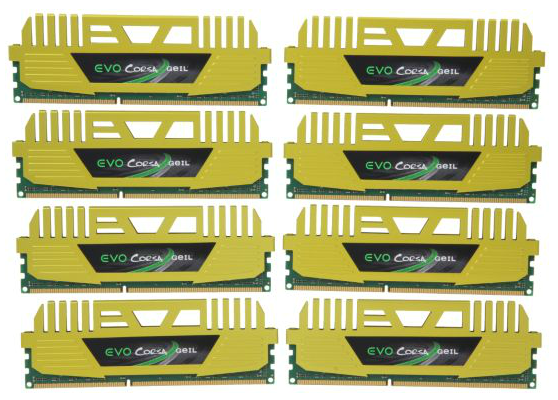
The Leggera range has similar speeds (up to 2400 MHz) and capacities (up to 4x8GB kits), but smaller blue heatsinks.

In contrast their Black Dragon range is heatsinkless, and comes in at only 1333 and 1600 MHz:
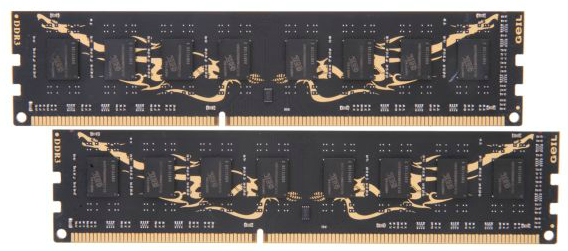
Today we are looking at one of GeIL’s Evo Veloce kits, kitted out in a ‘limited edition’ frost white. The heatsinks are large, and with two 8 GB modules, there leaves room for upgrades in the future.
GeIL Evo Veloce DDR3-2400 11-12-12 2x8GB Kit Overview
Back in the 'DDR3 on Ivy Bridge' overview, superlatives were not forthcoming with our DDR3-2400 C10 kit under scrutiny. It offered little performance gain over the DDR3-2133 C9 kit, but asked for another $15 for the privelege to exceed in peak synthetic results only. The GeIL Evo Veloce DDR3-2400 11-12-12 2x8GB kit then has a tough act to follow, coming in at $150 (more than the 2400 C10 kit) and having the timings reduced. The upshot of all this is more capacity per module, leaving the door open for future upgrades, or maximising the memory in a dual module system.
When making the jump from 4GB modules to 8GB modules, compromises have to be made. It could be construed that as everything is smaller, accesses should be quicker – but with double the density we can accrue additional latencies by reading larger rows in our memory module. Whether that actually makes a difference in normal day to day tasks is another matter – everything to do with memory and memory speed borders on the debatable when it comes to actually affecting everyday use.
In terms of the competition, solely looking at 2x8 GB kits means on Newegg we have two competitors – the G.Skill TridentX 2400 C10 kit ($155) and the Corsair Dominator Platinum 2400 C10 kit ($255). Going on solely XMP profiles, the G.Skill is the main competition, and being C10 is an advantage. However, a set of 2x8 GB from the Crucial Ballistix range at 1866 C9 ($150) could also give the 2400 kit a run for the money. Based on the calculation methods described in our original Ivy Bridge DDR3 overview, we having the following:
2x8GB DDR3-2400 C10 has a latency of 8.33ns, and will read 8 words in 11.25ns
2x8GB DDR3-2400 C11 has a latency of 9.16ns, and will read 8 words in 12.08ns
2x8GB DDR3-1866 C9 has a latency of 9.65ns, and will read 8 words in 13.40ns
Whenever we look for a memory kit, having something extra to talk about always helps – aesthetics or overclocking usually works well. While the Evo Veloce frost white modules look nice, they overclocked relatively well, hitting 1T with no issues, as well as overclocking to DDR3-2600 11-12-12 and DDR3-2400 10-11-11 at stock voltages.
Specifications
| G.Skill | GeIL | G.Skill | ||||
| Kit Speed | 1333 | 1600 | 1866 | 2133 | 2400 | 2400 |
| Subtimings | 9-9-9-24 2T | 9-9-9-24 2T | 9-10-9-28 2T | 9-11-10-28 2T | 11-12-12-30 2T | 10-12-12-31 2T |
| Price | $75 | $80 | $95 | $130 | $150 | $145 |
| XMP | No | Yes | Yes | Yes | Yes | Yes |
| Size | 4 x 4 GB | 4 x 4 GB | 4 x 4 GB | 4 x 4 GB | 2 x 8GB | 4 x 4 GB |
|
|
||||||
| MHz | 1333 | 1600 | 1867 | 2134 | 2401 | 2401 |
| Voltage | 1.500 | 1.500 | 1.500 | 1.650 | 1.650 | 1.650 |
| tCL | 9 | 9 | 9 | 9 | 11 | 10 |
| tRCD | 9 | 9 | 10 | 11 | 12 | 12 |
| tRP | 9 | 9 | 9 | 10 | 12 | 12 |
| tRAS | 24 | 24 | 28 | 28 | 30 | 31 |
| tRC | 33 | 33 | 37 | 38 | 47 | 43 |
| tWR | 10 | 12 | 14 | 16 | 14 | 16 |
| tRRD | 4 | 5 | 5 | 6 | 6 | 7/6 |
| tRFC | 107 | 128 | 150 | 171 | 362 | 313 |
| tWTR | 5 | 6 | 8/7 | 9/8 | 8 | 10/9 |
| tRTP | 5 | 6 | 8/7 | 9/8 | 8 | 10/9 |
| tFAW | 20 | 24 | 24 | 25 | 27 | 26 |
| tCWL | - | 7 | 7 | 7 | 11 | 7 |
| CR | - | 2 | 2 | 2 | 2 | 2 |
Visual Inspection
Usually the first thing we notice about the high end memory kits is the size of the heatsink. With the Evo Veloce 2400 C11 kit, the heatsink extends 17 mm above the module itself providing some but not an optimal amount of surface area to dissipate heat… if that was the primary purpose. Heatsinks on memory kits in the year 2012 tend to be on the kit for two reasons – the first is aesthetics, and as such if a user is producing a colored build then having memory the right color is a step in the right direction. The other reason is one of secrecy – more often than not memory vendors no longer disclose what type of memory is underneath and where they buy it from. We know that GeIL does its binning of the ICs, but they do not want other manufacturers to know which ICs are being used unless the manufacturer buys a kit and then rips it apart. These heatsinks are sufficiently bonded to the ICs that attempts to remove them will damage the module. Nevertheless, here are what the modules look like:
In comparison to other kits we have tested, we can see the extent of the heatsink. In the case of the G.Skill Ares, which is a standard height memory module:
In terms of the G.Skill RipjawsZ:
And against the tallest kits we have in, the G.Skill TridentX:
When placing such large modules into a motherboard, we must be aware of how large air coolers can affect the placement. Typically a large air cooler will encroach on the nearest memory slot, and thus choosing the right memory can be important. Following on from our previous memory testing, here is the attempt to get a GeIL kit into a Gigabyte H77N-WiFi which has a Copper TRUE mounted so the PCIe slot is not blocked:
The result is not good – I could not even get the module in. In contrast, here is the second slot:
While the module is in the slot, we are right up against the cooler and there is some pressure there against the module forcing it at an angle. Users with these modules may want to invest in some form of all-in-one liquid cooling as a result. In our actual testing we use an ASUS P8Z77-V Premium and a stock Intel cooler, meaning spacing is not an issue.


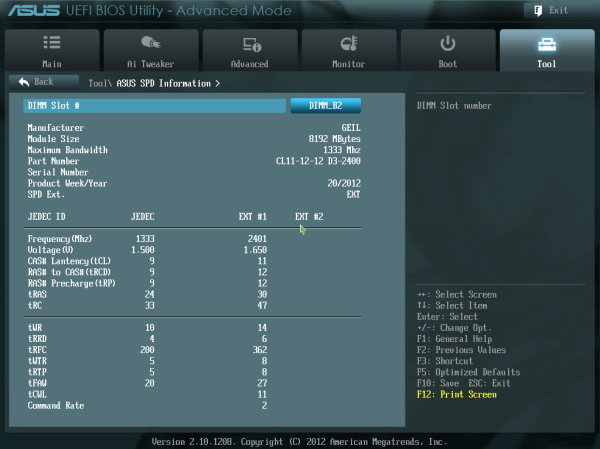
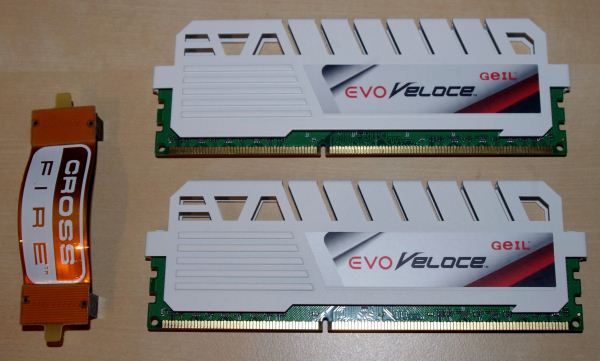
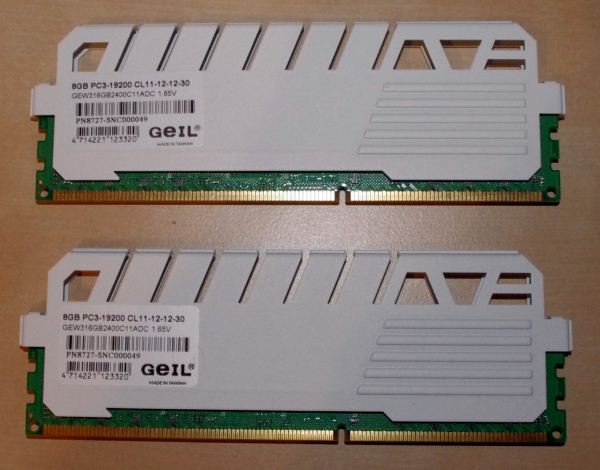



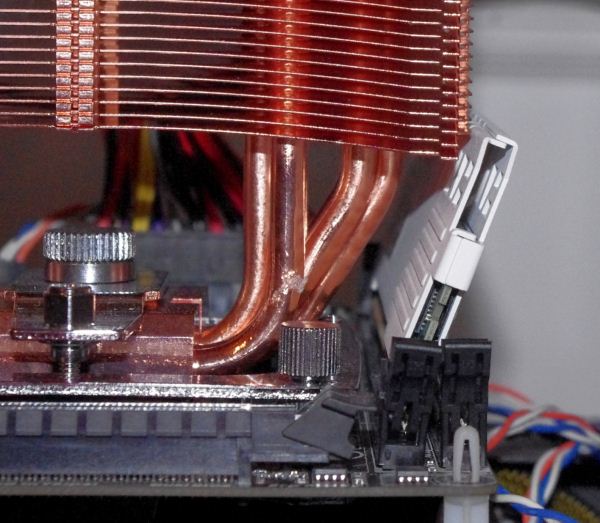
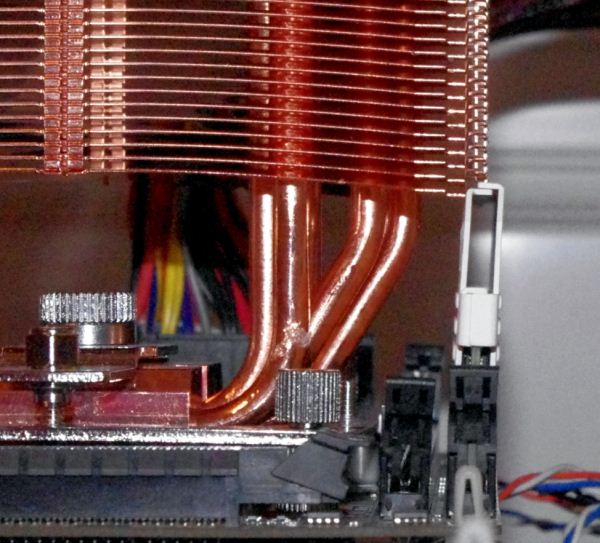














30 Comments
View All Comments
Tchamber - Wednesday, October 24, 2012 - link
It would be nice to see how memory impacts gaming with a graphics card. Or does the difference get so small that there's no meaningful difference?Magnus101 - Wednesday, October 24, 2012 - link
I think it already is no meaningful difference in most games, even with the integrated GPU!As with all memory performance tests, the real world difference is so small that it makes no sense to throw money at higher speced memory.
Almost in all circuimstances, perhaps except some special cases like they highlighted in an earlier article hear at anand.
The biggest difference there was for Winrar64 compression (not the usual unpacking we normal user do almost daily) and that was still only 20% differece between 1333 and 2400.
I haven't seen any benchies with memory for compilers (programing) or for DAW (music making, like with cubse, sonar and so on), but I suspect it is the same old story of almost no difference.
tekphnx - Thursday, October 25, 2012 - link
Second Life at max settings is a notable exception. I recently upgraded from DDR3-1600 to DDR3-2000 on my i5-760 @3.8ghz with GTX670, and saw a jump of 5-6fps in minimum framerates.JonnyDough - Friday, October 26, 2012 - link
I COMPLETELY agree. This article is BOGUS. Here's why:If you're going to spend money on higher end memory then you may as well fork over a little for a discreet graphics card instead. It will make much more difference in games.
Intel integrated graphics are only good for office usage still. No real gamer or anyone doing heavy GPU calculations, cares about Intel IGPs.
Show us what this more costly memory does for a real gamer and we'll consider purchasing it. Three frames per second more on an IGP is not worth the money spent on this memory.
IanCutress - Friday, October 26, 2012 - link
That's the thing - not everyone that has a PC uses it for gaming. As alluded to by Magnus, there are other things that do not need a discrete GPU but are still used by a large number of enthusiasts - VMs, compilations, even non-parallel scientific simulations. You whack in a stupidly large matrix into memory and it will bog down. Failing that, how about financial calculations? Now put all that inside a mITX chassis and board where you're limited to two memory slots. Sure 2x8GB 2400 C11 may not be your first port of call, but if saving an extra 3-5% time on whatever you do actually has a financial impact on your work portfolio, then the early investment could pay off in the long run. Then again, it may not and that 2x4GB 1333 C9 is looking a little sweeter.No article is bogus, as you put it. Sure there are good things to review and some that are not so good. If we solely focused on the good, then we'd all be sitting around patting each other on the back for doing a service to the industry. I like reviewing all sorts - you get to see the niggles of the smaller companies that can't invest, or you can point out when a top company is just being stupid. Thus when you get a really good product that shines out from the rest, it is something special to behold.
Ian
PS There are plans for a compilation benchmark in future reviews. I'm trying to organise a decent one that I can strap a timer to without sitting in front of the screen for 20 minutes waiting for it to finish.
Runamok81 - Friday, October 26, 2012 - link
True, not everyone uses a PC for gaming. But do you really think the "frost white" Evo Veloce memory is targeted towards the financial or enterprise sector? As silly as it is, Enthusiasts with money than sense WILL pay a premium to raise their benchmark synthetics.ytoledano - Wednesday, October 24, 2012 - link
Sticks like these coupled with a X79 motherboard with 8 DIMMs populated are biting into server territory - I'm sure! I'm running a 3930K + 48GB (I will soon have to upgrade to 64) as a dedicated SQL server. How much would similar performance cost me if I'd built the system around a Xeon? Probably twice.Blibbax - Wednesday, October 24, 2012 - link
Roughly £400 extra for the Xeon equivalent of the 3930K.quixver - Tuesday, November 20, 2012 - link
You are missing out on ECC though.Beenthere - Wednesday, October 24, 2012 - link
Anyone who has actually tested higher RAM frequencies or RAM quantities above 4 GB. in a typical modern desktop PC knows that frequencies above 1600 MHz. produce no tangible system performance gain in either Intel or AMD powered PCs. Tangible means a change in system performance that you can actually see and or feel. In addition more than 4 GB. of RAM produces minimal gains unless you operate your PC with many applications open or functioning concurrently, which most people don't. CAD, modeling, and some other business applications CAN benefit from more RAM but many consumer apps don't.Be advised that RAM benches grosssly mis-represent the actual SYSTEM gains because they assume the RAM is saturated 100% of the time, which it is not. If you run real applications and compare 1333 MHz. to 2400 MHz. you will likely not even be able to tell the difference between the two because DDR3 RAM @ 1333+ MHZ. is not a system bottleneck.
The RAM mfgs. are doing everything they can to convince enthusiasts to buy high priced high frequency RAM because this is very profitable for them. When you test with real applications and see how tiny the system gains are, you will wish that you had bought 1600 or 8166 MHz. RAM at a reasonable price and used the cash for a faster CPU or GPU.
If you have money burning a hole in your pocket then by all means buy the fastest RAM you can find. Then you can brag at how cool it is... even if you can't actually use the highest frequency in your PC. Understand that your CPU may not be able to run the RAM anywhere near it's rated frequency. Typically Deneb CPUs top out around 1600 MHz., Thubans around 1800 MHz., Zambezi at 2000+ MHz. and Vishera around 2400 MHz. based on initial testing for Vishera. No one cares about Intel CPUs so I won't post on them... <LOL>